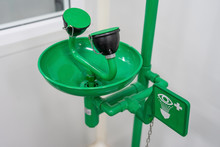The most common incidents in the chemical laboratory are chemical splashes in the eye.
Making sure correct eye protection is provided and worn as well as handling corrosive chemicals with suitable care should offer sufficient protection. But accidents can still sometimes happen.

Send for a first aider and then immediately wash the eye with running water for at least 10 minutes, and for much longer in the case of alkalis. The flow should be slow and the eyelids should be held back. If the victim is wearing contact lenses see if it is possible to remove them after an initial rinse though this is not vital.
Run the water from the nose towards the side of the face – the other way could lead to contamination of the other eye as well
Afterwards the casualty should be taken to hospital (and, for alkalis, irrigation continued during the journey).
If you have a plumbed in eyewash station (as in the image above) then that’s great but most schools do not.
Eyewash bottles work but are far too small. To irrigate for the required length of time for a significant alkali exposure would take 20 or more bottles of solution!
The best option is a length of rubber tubing, sterilised with Milton's fluid or similar, and then put in a labelled bag above a sink. This can then be placed over the tap and used to gently irrigate the eye. Don’t worry if it is not sterilised. The worst case scenario is a case of conjunctivitis which is easily cleared up.
